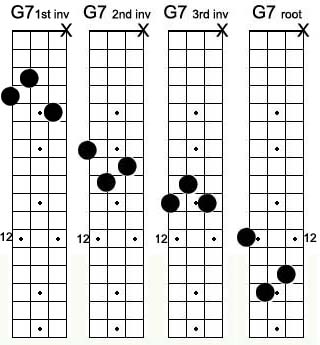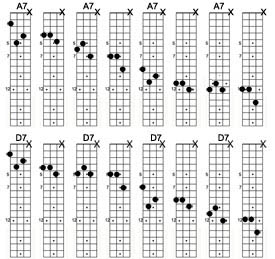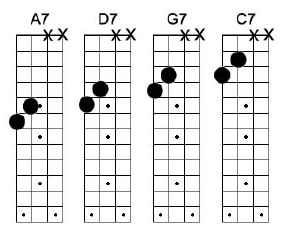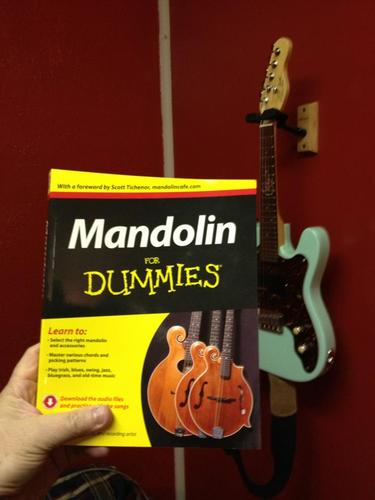« September 2012 |
Main
| November 2012 »
 October 25, 2012 | 7th Chord Streams
October 25, 2012 | 7th Chord Streams
In our five part series on chord vamps, we featured a progressive look at how you could spice up some stagnant chord sections of music. Let's say you had 2-4 measures of a G chord, you could enhance the energy of the song by simple diatonic triads, inserting fleeting V7 chords (scurry dominants), manipulating the Circle of 5ths, and even juicing up similar minor chord patterns.
Don't make the mistake of looking at this as making the simple more complex. It's really taking something stark and injecting systematic, repeatable enhancements to make accompaniment more engaging to yourself and the listener. In each lesson, we give something that will not distract from, but propel the existing harmonic structure.
 . .
We're introducing you to a stream of 7th chords. In our Mandolin Sessions article Static Changes: V7 chords we showed how you could play 4 different inversions of the same V7 chord in 3-note patterns. You can play these up and down the fretboard, but leaping more than 3 or 4 frets at a time is awkward to hands and ears. In the accompanying PDF pages, we'll connect these chord with a passing chord to smooth the movement.
Understand, mastering these streams gives you the capability of generating some interesting V7 patterns in all 12 keys. We're just giving you four, but you can move them around yourself, up a fret or two, down--you have the whole ball of string.

Print PDF: 7th Chord Streams
Try these out on your favorite simple blues song. You can turn 4 measures of G7 into something that sounds complex, yields energy, but doesn't change the harmonic integrity of the music. If theory isn't your thing, just play the blocks. They sound good enough on there own, even if you don't understand the mechanics of why.
Let us know how this helps your playing!
Further
Vamps Pt 1. Creating energy with Diatonic triads
Vamps Pt 2. Expanding the Diatonic triads
Vamps Pt 3. Scurry Dominants
Vamps Pt 4. Circle of fifths
Vamps Pt 5. Minor modal
Posted by Ted at 9:02 AM
 October 18, 2012 | V7 Melodic Patterns
October 18, 2012 | V7 Melodic Patterns
Enjoy the popular archive material below.
From March 24, 2011: "V7 Melodic Patterns"
We spent some time a few weeks ago looking at combinations and inversions we can adapt to a Dominant 7th (V7) chord. This time out we want to look at melodic opportunities in improvising around the V7 chord. As we mentioned, in 12-bar blues, we have entire songs made up of V7 chords, and knowing how to extract the best notes is crucial in effective soloing.
The most basic choice is to take the chord's major scale, and lower the 7th scale degree. If you're into labels, this is called the Mixolydian mode.
A Major Scale: A B C# D E F# G# A
A Mixolydian: A B C# D E F# G natural A
In our functional hierarchy, the 3rd (Major) and the 7th (Minor) of the group of notes expresses the V7, and anything else supports the defining character. Notes of the scale help, accidentals give variety, but you need the C# and the G natural to convey the essence of the harmony.
In a D7 chord you have:
DMajor Scale: D E F# G A B C# D
D Mixolydian: D E F# G A B C natural D
If you were playing the blues, you'd want to use both scales, and for character, include the minor 3rd and diminished 5th for flavoring, but again it's the 3rd and 7th of each scale that communicates its harmonic nature. Rather than start each note on its root, how about some ergonomic efficiency and smooth voice leading starting the batch on the same notes, in this case the A. On a fretboard, it would look like this in the lower octave:
 
Notice the red notes are not only the only notes that are different in the two patterns, they are also the most important ones in defining the "A7ness" and the "D7ness." There's also a distinct geometric relationship we can pull out, not only in different octaves of the scales, but in different keys. You may recall a progression of 5ths we mapped out in our "Lizard Ear Chords" series at mandolinsessions.com.

You could start the notes on other fingers using the FFcP approach and really open up the possibilities up, down, and across the fretboard, but for now, just work on the A7/D7 combination in the lower octaves, with the 1st FFcP diagrammed above. Try repetitive measures on the A7/D7, and if you want to finish out a 12-bar Blues, all you have to do is add the E7 notes by moving the D7 up two frets.
 
One thing you want to get away from is making your solos sound like you're practicing scales, so try experimenting with both octaves moving up in thirds or fourths. Start in the middle of the scale and go down and back, up and back. Include arpeggios of the A7 and D7 chord. Look to some of the variety in the FFcP exercises to include some melodic variety.
And when you're ready, try other keys, D7/G7, C7/F7, F7/Bb7, Eb7/Ab7. Go nuts!
Further:
Two-chord jam; feed the beast.
Moving Forward; Melodic Progression
Critical Decisions in Improvising: 'Gravity' Notes.
Playing musically: Part 3, play with direction
Blues 501 Jazz!
Posted by Ted at 7:30 AM
 October 11, 2012 | Cafe Interviews
October 11, 2012 | Cafe Interviews

Looking for the opportunity to get into the heads of some of your favorite contemporary
mandolin authorities? We've had the privilege of personally interviewing some of the stars the last three years. You can harvest these insights and words of wisdom over at the Mandolin Cafe with the links listed below. Grab a mug of Java and sit down for some great reading.
An Interview with Don Julin, author of Mandolin For Dummies
Ted Eschliman interviews author Don Julin about his forthcoming book "Mandolin For Dummies."
September 9, 2012
10 Questions For Jason Anick
Ted Eschliman interviews Jason Anick, jazz mandolin and violin virtuoso and new faculty member at Boston's Berklee College of Music.
July 1, 2012
10 Questions For John McGann
Ted Eschliman interviews John McGann, the central figure behind the outstanding mandolin program at Boston's Berklee College of Music and his role as mentor to some of today's top upcoming stringed instrument stars.
July 24, 2011
10 Questions for Will Patton
Ted Eschliman catches up with Vermont based jazz and swing mandolinist Will Patton for another Mandolin Cafe exclusive interview.
April 24, 2011
10 Questions for Aaron Weinstein
Ted Eschliman catches up with jazz violinist and mandolinist Aaron Weinstein for another of our special feature interviews.
February 1, 2011
10 Questions For Don Julin
We catch up with Traverse City, Michigan-based Don Julin, one of the busiest working mandolinists in the country. You may be hearing his music on TV and Film.
November 7, 2010
The Don Stiernberg Interview
The Mandolin Cafe's message board members engage Chicago-based jazz mandolinist extraordinaire Don Stiernberg for another of our exclusive extended interviews.
March 17, 2010
The Paul Glasse Interview
The Mandolin Cafe's message board members engage Austin, Texas based jazz mandolinist Paul Glasse for an extended interview.
December 15, 2009
More Mandolin Cafe interviews.
Posted by Ted at 9:01 AM
 October 4, 2012 | Touchdown: "Mandolin for Dummies"
October 4, 2012 | Touchdown: "Mandolin for Dummies"
"Don't never go full Dummy."
Paraphrase, Robert Downey Jr, Tropic Thunder

Okay, it's a rough paraphrase, but also a touch of irony that scholarly material, about anything out of The Dummies lifestyle books could be so helpful. Each book is intended to be a bridge for the uninitiated, a trip somewhere down the path of expertise, and Don Julin's entry "Mandolin for Dummies" proves no exception. We ordered our copy in July, and are happy to have it in hand.
We've got nothing but praise for the hard work put in covering such a wide variety of topics related to the mandolin. History, instrument physiology, playing techniques, music styles, and a heaping boatload of references and external resources. Julin's ability to be comprehensive, academic, but still bring it all to a street-savvy, real-world sensibility is impressive. 378 pages to cover all that's mandolin? Not an easy chore, but the upper midwest US native was definitely up to the task.
Though tightly organized book should be approached like a method book, rather the reader should feel free to encyclopedia to skip around chapters and dig out information in smaller doses over a long period of time. Definitely something to keep permanently on the bookshelf. Most of the information is more "contemporary," not so much of the three centuries of the instrument, but that's not the purpose of the book. The "Dummy" approach means any mandolinist, even if he/she doesn't own an instrument yet can find something useful immediately. Songs are available in traditional and TAB notation, photos show clear playing and handling techniques, and greyed-out trivia paragraphs take interesting side trips into the periphery of mandolinning.
We had the pleasure of posting an interview with the author last month. You will find the process of tackling a project as vast as this intriguing, so take the time to look under the hood. It will help you appreciate the book even more.
Mandolin Cafe: An Interview with Don Julin
Purchase link: Mandolin for Dummies
Further:
10 Questions For Don Julin
The ii-V-I chord progression Part 1
The ii-V-I chord progression Part 2
The ii-V-I chord progression Part3
Posted by Ted at 8:12 AM

Disclaimer: In the 'Information Age' of the 21st Century,
any fool with a computer, a modem, and an idea can
become a self-professed 'expert." This site does not
come equipped with 'discernment.'
|



